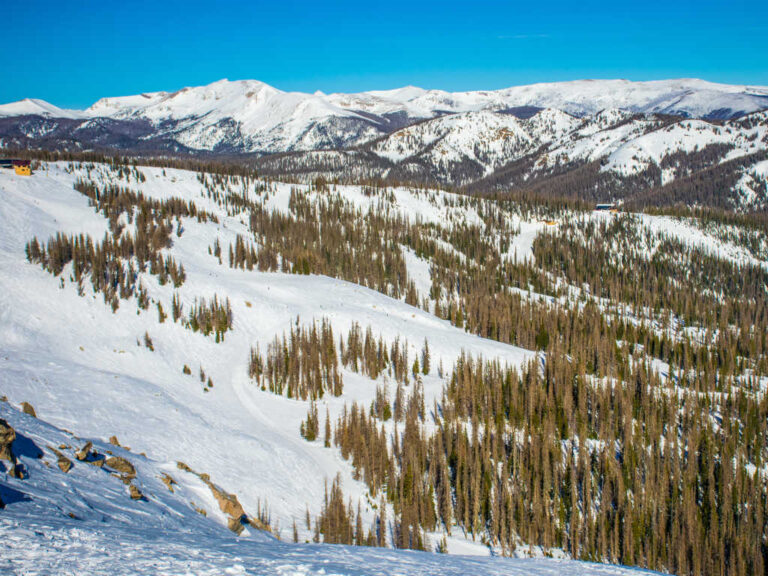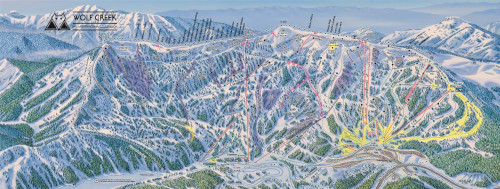Wolf Creek Deals & Travel Info
Wolf Creek is a sprawling family-owned ski area located in the southern San Juan Mountains just an hour and a half away from Durango. Wolf Creek boasts the most snow in Colorado, averaging over 400 inches per year! Located at the top of the Continental Divide on Wolf Creek Pass, you can choose to stay nearby in Pagosa Springs on the west side, or the smaller destinations of South Fork and Del Norte on the east side. Wolf Creek Ski Area is quite a drive from Denver; you may want to cough up the cash to fly to Durango and save yourself the five-hour drive.
Wolf Creek Vacation Deals
Ski Rental Deals
Transportation Deals
Mountain Stats
- Trails: 77
- Skiable Terrain: 1,600 Acres
- Total Lifts: 10
- Avg. Snowfall: 430"
- Vertical Rise: 1,604'
- Peak Elevation: 11,904'
- Base Elevation: 10,300'
Wolf Creek Ski Resort Highlights
This is a medium-sized family-owned ski area known for its expert terrain, huge snowstorms, and short lift lines.
- Located in the beautiful southern San Juan mountains
- Boasts the most snow in Colorado
- Vast expert terrain
- Excellent views of the Continental Divide
- Independently-owned

Getting to Wolf Creek
From Denver International Airport, take the scenic US-285 all the way to the town of Center, where you’ll hop over to US-160. This will take you through the towns of South Fork and Del Norte, both of which offer great lodging options. You can continue over the top of Wolf Creek Pass and stop at the resort, or continue and head down the west side to the comparatively more bustling town of Pagosa Springs, which hosts more restaurants and shopping. From Durango, simply drive one hour east on US-160 to the top of the pass and the ski area.
Wolf Creek FAQ
While Wolf Creek is known for lots of snow and steep expert terrain, there are plenty of runs for the whole family! There’s extensive beginner terrain and excellent ski instructors to get you on your way.
To beat the crowds, try to ski during the weekdays and not during holidays. Late season, such as February or March, is excellent as there will be plenty of snow. Wolf Creek is also known to open early in the winter, so this can be a good place to get your first turns of the season in.
All parking is within walking distance of the ski lifts, but the ski area does offer shuttles on busier holidays or weekends. Simply follow the parking attendant’s directions upon arrival.
Wolf Creek is a bit of a commute, as there is no lodging at the mountain itself. You can stay in Pagosa Springs on the west side of the pass, which has plenty of restaurants and world-renowned hot springs. There’s also the relatively quieter Del Norte and South Fork to the east, which offer beautiful views of the San Luis Valley.
While Wolf Creek has less terrain in terms of acreage, it’s also quite a bit quieter than other mountains, especially if you travel there on a weekday and not during the holidays or spring break. Wolf Creek is also privately owned, so offers more of a small-town family feel to the area.
Tips for Skiing at Wolf Creek
Check to see if the Horseshoe Bowl snowcat is running. The Horseshoe Bowl is the iconic treeless area on the far skier’s right side of the ski area. On many days, Wolf Creek runs a backcountry snowcat that takes you most of the way to the bowl so you can avoid the rather lengthy hike. Look for a sign at the lift operator shacks at the bottom of the lifts for more information.
Be prepared for some traversing. Especially if you’re a snowboarder, be sure to keep your speed up on the catwalks or be ready to walk. You’ll have to utilize these catwalks to get around, especially if you’re a beginner and need to avoid steep runs.
Be ready to hike! Much of the awesome terrain at Wolf Creek isn’t accessible by the six lifts at the ski area. Hikes can range anywhere from 5 to 45 minutes.
Stick to Raven and Nova lifts for beginner terrain. The looker’s right side of the mountain has the best beginner terrain. Avoid Treasure lift if you’re a true beginner, as there are only blues and black diamonds to choose from.
Ski the Waterfall Area. For some accessible steep terrain that you don’t have to hike to, try the Waterfall, a series of chutes accessed by any one of five gates. Ride Treasure lift and take a left off the top to Navajo Trail and choose a gate. Just be on the lookout for cliff signs and definitely don’t duck any ropes, as there are dangerous cliff bands located throughout the runs.
Hike the peak. Dominating the view is the iconic Alberta Peak, which tops out at almost 12,000′. You can access the hike from either the Treasure or Alberta lifts, but the Treasure side is a bit of an easier hike. You’ll get incredible panoramic views of the San Juan Mountains and San Juan River Valley.

